
Eight seconds. That’s the marker of the ultimate challenge, not just for bull riders, but for digital marketers too. Research has shown that the human attention span is only eight seconds, suggesting that when targeting consumers via email, you have mere moments to inform, entertain, and ultimately persuade them to take action. Luckily, it’s not as hard as it sounds.
Grabbing attention among a noisy inbox is about being contextual and relevant. Every message needs to be personalized for the best chance of success. But being personalized in today’s digital marketing world doesn’t mean manually emailing individuals on a one-by-one basis. To target the right contacts at the right time (and at scale), determine key moments in your customer journey, define audience segments, and trigger marketing messages automatically based on a combination of demographics and behavior.
So you know you need to show value fast and do so at the right time—what are the key moments in a customer’s buying journey and what messages are proven to work? Here are best practices for six popular email types fast-growing SaaS companies use to nurture customers:
#1 - Welcome emails
Welcome emails are typically sent immediately after a user signs up for a free trial to encourage them to log in, and to make them feel welcomed to your service. Inject humor, a friendly face, or simply give direct access to key account information, depending on your style.
HTML-based welcome emails: Squarespace takes a direct approach in its welcome email to ensure users can immediately find their website URL, login details, and account settings. They also exemplify their people centric, trusted advisor values with real employee photos.
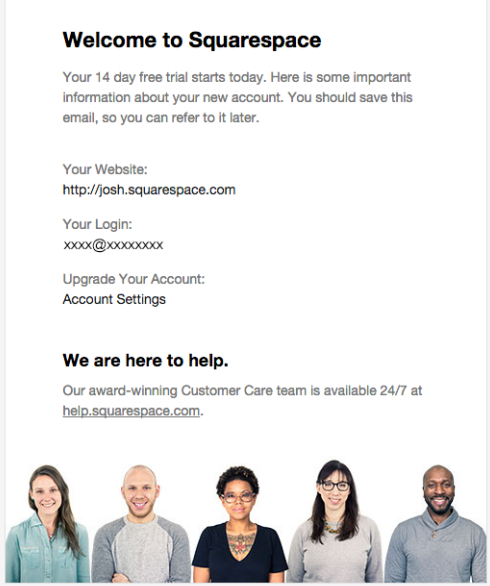
Squarespace welcome email
In comparison, GoodReads takes a prescriptive approach to helping users recognize value quickly: follow your favorite author, join a group, then win a free book. Ensuring that new users don’t have to wonder where to start by directing them to your key behaviors, and linking to helpful getting started content, is an easy way to significantly increase activation rates.
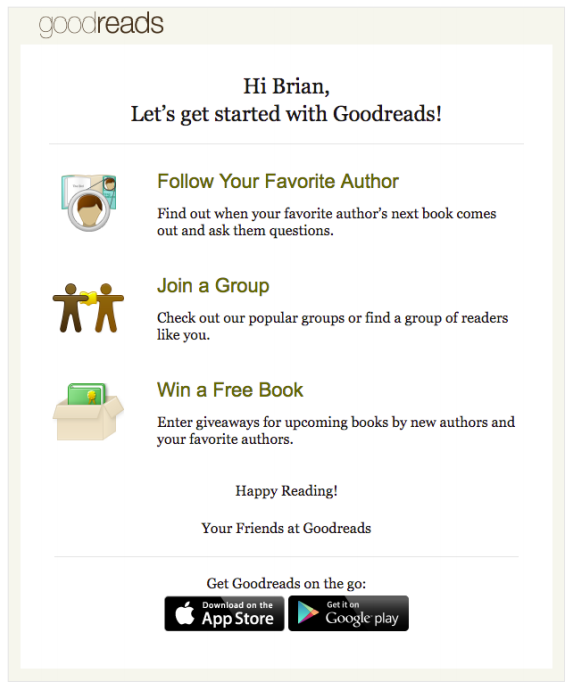
goodreads welcome email
Text-based welcome email - StudySoup: Susan Su uses this example in her ultimate email playbook.
This email is effective because it sets expectations (“in the next few days, I’m going to send you…”), it’s plain text, so it feels more personal, and it has calls to action that get people back into the product.
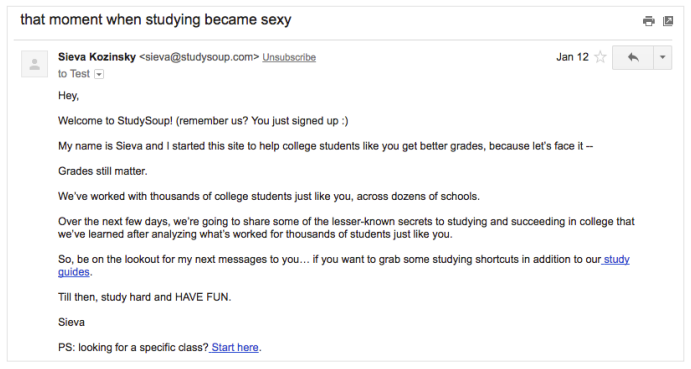
#2 - Usage tips
Send a usage tip email after one to two sessions to drive product engagement and help your user be successful. The objective for this email is to help your user achieve the next key event.
Common use cases for usage-based tips include:
- Directing users to a specific in-app page (e.g. “Manage users” page)
- Inviting inactive users to an orientation demo (e.g. “30-minute crash course on how to share documents and collaborate between teams”)
- Linking to specific help center articles or blog posts (e.g. “how to invite a user from outside your company”)
- Giving actionable best practices, or inviting abandoned users back in (like the Zapier example below)
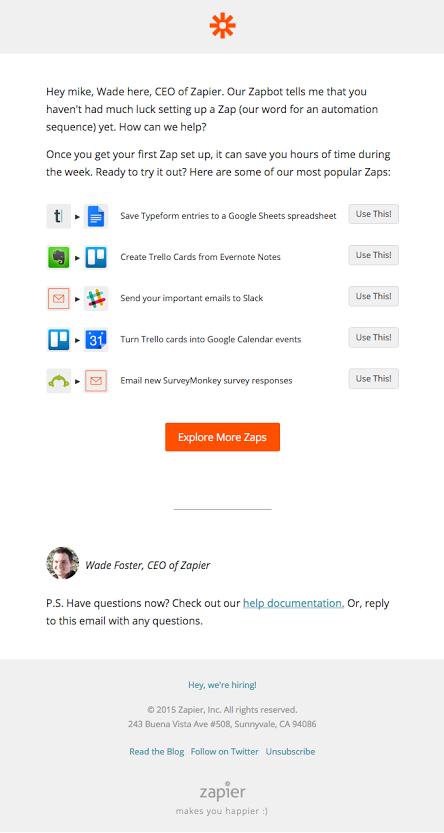
Zapier usage tips email
#3 - Sales touches
A sales touch email should be sent within 24 hours of receiving an inbound request to schedule a sales or success meeting, if needed. Use a text based email and Calendly or MixMax to eliminate the hassle of scheduling, and enable a single rep to serve a high volume of customers in a 1: Many manner.
Text-based sales touch email - Autopilot: At Autopilot, in addition to the branded, usage-personalized onboarding emails we send to all trialists, we send text-based sales outreach emails to large qualified leads. These initiate an assisted sales process for more complex, mid-market customers, and are addressed from the sales rep who was automatically assigned to the inbound lead.
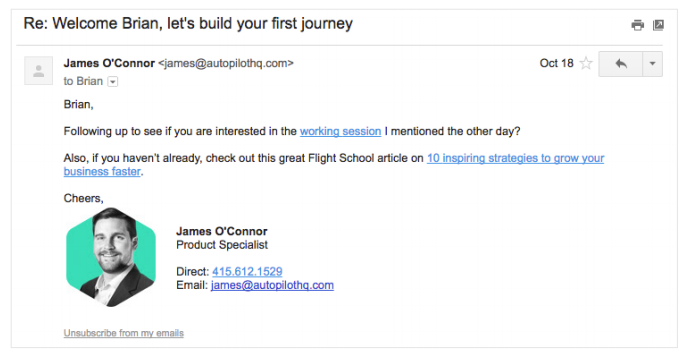
Autopilot sales touch email
Notice the name personalization in the subject line: “re: Welcome Brian, let’s build your first journey.” Also, James (the sales rep) includes an offer for a working session, putting the ball in the contact’s court to schedule a call. This is hassle-free scheduling and offers value rather than being needy and pushy.
#4 - Usage review
Halfway through your free trial, send a usage review email to give users a bird’s-eye view of their progress and suggest areas to explore further. Salesforce started sending their successful Personalized Account Review emails in the mid-2000s by injecting feature usage into roll-up fields in a monthly email and linking to online resources for unused features that are areas to explore. Since then, many vendors have launched highly clicked and much appreciated usage review emails, which is easy to do with tools like Segment that can sync events into your automation system.
Usage review HTML email - Zendesk: Zendesk takes the usage review email to a whole other level by including aggregated data to benchmark your performance against relevant peer groups:
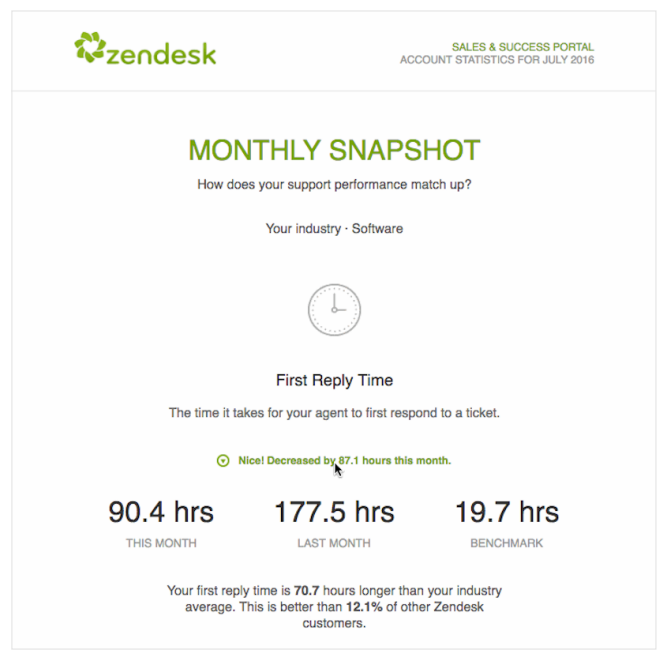
Zendesk usage review email
Notice the three highlighted metrics followed by a short human-readable statement summarizing how you fare against all other Zendesk customers. This lights a fire under slow starters to ramp up their customer service efforts, while tacitly giving top performers a pat on the back.
#5 - Expiry warnings
Send an expiry warning email with one week left in the trial to remind users to buy. Be helpful and confident, not pushy and salesy.
Expiry warning HTML email - Basecamp: Basecamp pings users 5 days before their 45-day trial expires.
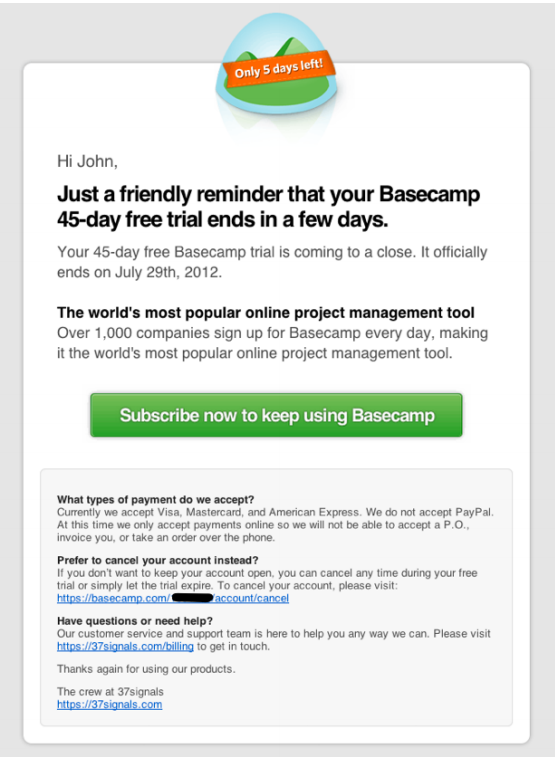
Basecamp expiry warning email
The company reminds the recipient of the length of their trial (since disinterested users may assume they had more/less time and request an extension) as well as of their upcoming expiry date (so they know when they need to pay by). The impossible-to-miss, green (i.e. non-urgent) call-to-action button is center-aligned below the reinforced value prop. Finally, notice the inclusion of FAQs to proactively address common buyer concerns.
#6 - Feedback emails
Send a feedback email post-trial if the user hasn’t converted to a paying customer. Include a link to a survey that helps gather info to make your product better. Use a thankful tone.
Here’s the feedback survey we send at the end of our trial experience at Autopilot:

Autopilot feedback email
The email is text-based, super simple, and sent from our Product Marketing Manager. It links to this feedback survey:
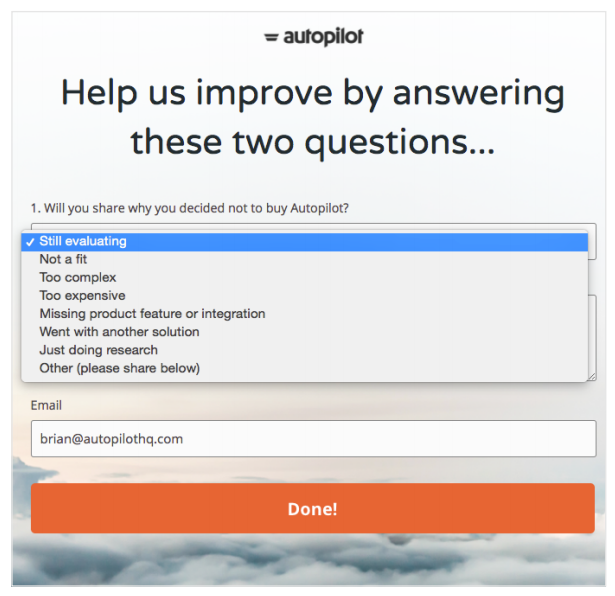
Autopilot survey
We find that 27% of our expired trialists don’t buy because they’re still evaluating their options, providing us an automated opportunity to offer a call with sales, or to nudge them back into product. It’s a win-win.
The eight second rule can make crafting a customer message into a whole new rodeo. But, by aligning your customer needs with the right timing and prose, you’ll connect on a personal level and attain your conversion goals faster than ever before.
